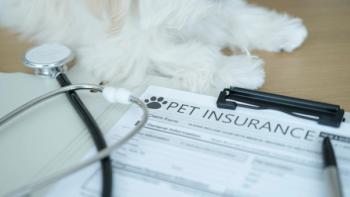
Study: graduates mired in debt
More than 88 percent of this year's new veterinarians graduated with educational debt averaging $88,077. Now working, they're taking home less than $44,000 a year.
More than 88 percent of this year's new veterinarians graduated with educational debt averaging $88,077. Now working, they're taking home less than $44,000 a year.
That's less earning and more borrowing compared to last year for the 80.5 percent of all spring 2005 DVM graduates who answered the American Veterinary Medical Association's (AVMA) annual poll. It's also a call for more fiscal responsibility and financial planning, says Barbara Berman, assistant dean for student affairs at Tufts University Cummings School of Veterinary Medicine.
While Berman describes the indebtedness trend as "alarming," she's not surprised the bill keeps climbing.
"Tuitions are astronomical," she says. "There are veterinary students graduating all over the place that are borrowing over $90,000. Still, there are ways students can save thousands in the long run."
Financial literacy
That doesn't just mean eliminating all discretionary spending. "Veterinary students would lose their minds if they did nothing but study all day," Berman says. What she suggests is car pooling, attending sponsored seminars offering meals and exploring options for modest housing.
While many financial gurus suggest making payments on interest-accumulating loans while in school, Berman says that's not a realistic option for most veterinary students.
Apart from cutbacks, borrow only what's absolutely necessary, and keep abreast of how much is being taken, she advises.
"Some students ignore their debt because it seems so overwhelming, and they're so immersed in their studies," she says. "At Tufts, we don't want any major shock. Because we're in their face a lot tracking borrowing and financial aid, the vast majority of our students know what they owe. That doesn't mean it's easy to swallow."
Bright spot
Despite the worsening earnings/loan ratio, AVMA Research Projects Manager Allison Shepherd says starting salaries reported by the study are skewed by the increasing number of graduates moving on to advanced study rather than full-fledged careers.
"Thirty percent of the students this year went into advanced study, and that's dramatic," she says. "Last year it was 25.7 percent."
According to AVMA's study results, those graduates are earning a mean starting salary of $25,100 a year compared to all private practitioners with a reported mean starting salary of $51,416. New graduates entering small animal exclusive practices reported the highest mean starting salary at $53, 796 (see Table 1).
Table 1: Mean starting salaries for 2005 graduates of U.S. veterinary medical colleges by employment type
Loan calculator
That's not a lot when factoring debt, Berman says.
"I've seen a student with debt in the neighborhood of $160,000," Berman says. "You can imagine that's a high payment."
Table 2 : Total educational debt of 2005 graduates of U.S. veterinary medical colleges
For a student who graduates with $90,000 in student loans at 5-percent interest and opts to pay over 20 years, monthly payments will reach nearly $600. By the time the borrower pays off the loan, he or she would have paid $52,550 in interest.
That same loan paid over 10 years at 5-percent interest yields a monthly payment of $954 but accumulative interest of just $24,550.
Berman says it's a good idea to opt for the longest repayment period available — often 30 years — but make it a personal mission to pay down the debt as soon as possible.
"That way you have the luxury of making smaller payments if and when you need to," she says. "If you run into a problem one month, you won't be penalized."
To calculate educational debt, visit
Newsletter
From exam room tips to practice management insights, get trusted veterinary news delivered straight to your inbox—subscribe to dvm360.






